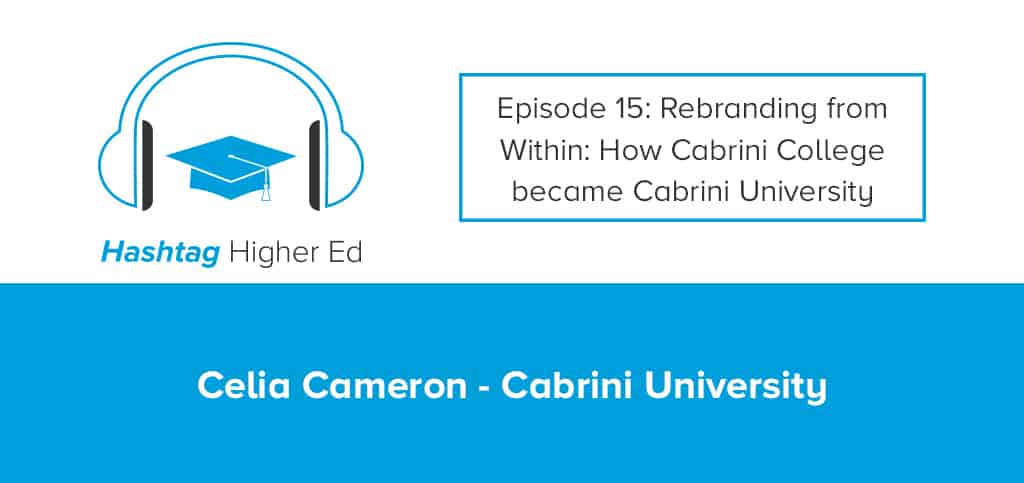When Celia Cameron joined then Cabrini College in January 2015 as Vice President of Marketing and Communications, she immediately noticed that the college was missing something: a brand. “The college, at the time, had very little brand awareness,” says Cameron. “There were a lot of brand misconceptions out there. A lot of people thought we were an all-women’s college when we had been co-ed for 40 years.”
Around the same time that Cameron joined Cabrini, so did a new President, with an aggressive growth plan that included expanding outside the region, new doctoral programs, and a greater emphasis on international recruitment.
While Cameron already had her eyes on an updated Cabrini brand, her timeline, in accordance with the President’s mission, was about to be accelerated in a major way. “We thought we were going [to change the name] from Cabrini College to Cabrini University in 2017,” says Cameron. “We found out in August of 2015 that it was going to be 2016.” Cabrini eventually decided that their name change would become official in July 2016, which only gave Cameron and her team 11 months to completely rebrand the organization.
Setting Priorities
Cameron says that while the time crunch was challenging, it also helped the process in some ways. “The reality is that the 11 months helped us have a sense of urgency on campus that wasn’t there before and gave us a firm goal,” she says.
Further adding to the challenge was a lack of budget for the process — Cameron says that was due to their original estimate that the process would take place in 2017, not 2016. In response to the new timeline, Cameron’s team, in partnership with the President’s office and a few other key stakeholder groups on campus, pooled their resources to come up with roughly $100,000 for the project. Cameron says that when they evaluated their resources, they realized that bringing in a branding consultant would eat up most of their budget. Instead, they decided to invest in themselves.
“A lot of people thought we were an all-women’s college when we had been co-ed for 40 years.”
Part of that internal investment meant conducting a reorganization of Cabrini’s marketing team. “We had great people here,” says Cameron, “but they weren’t right for their roles. We were set up originally as a newsroom.” After a team reorg, Cameron had a team of eight people, including herself, on which to run the rebrand.
Celia Cameron’s Rebrand Marketing Team:
- Vice President for Marketing and Communications
- Director, Content Marketing
- Assistant Director, Content Marketing
- Media Coordinator and Writer
- Creative Director
- Director, Media Relations
- Digital Designer
- Assistant to Vice Presidents of Institutional Advancement and Marketing and CommunicationsBuilding Relationships
“Without relationships and the connection to the community and key stakeholders, this would never have been as successful as it was,” says Cameron. As Cameron embarked on this rebrand process, she focused on getting the community, including faculty, staff, and students, to understand marketing and to understand and know Cameron’s team.
“When I was having my first conversations on campus,” she says, “some of the faculty and staff, who had been here for years, would not know who I was talking about, and it was someone who had also been here for quite some time.”
In an effort to build relationships, Cameron did away with project request forms, instead assigning various members of her team as liaisons to 1-2 departments on campus. Cameron says that while this helped colleagues get to know each other, it also did something much more important: it built trust.
“If, as we were exploring the brand and bringing together a new logo,” says Cameron, “the same conversations about not knowing us were still happening, it wouldn’t have worked.” That’s because, as Cameron points out, she wasn’t executing the rebrand herself. Her staff was. “It can’t just be about me,” says Cameron. “Our creative people, our writers, they are the people building the brand. So their relationships with the community are equally as important.”
To further facilitate relationships, Cameron organized informal feedback meetings with key stakeholders and formal open houses with the larger Cabrini community. Then, based on feedback, Cameron’s team would regroup and brainstorm. “You can’t do this in a bubble. This process can’t happen without talking to people.”
Rebrand Results
In July 2016, Cabrini University was officially launched, along with an updated logo and new tagline. Perhaps more importantly, Cameron’s team also established an official color palette — prior to the rebrand, Cameron says that while Cabrini’s colors were blue and white, it was not uncommon to see red, pink, gold, and other colors mixed in inconsistently.
For the first time in Cabrini’s history, Cameron’s team also launched a formal brand framework, with a brand promise, brand pillars, and brand stories to amplify Cabrini’s message.
Maintaining the Brand
In many ways, launching the new Cabrini University brand was only the starting point for Cameron and her team. “That was something that we had to think about before we even launched,” says Cameron. “What’s going to change? How do we promote these three brand pillars? That’s something we’re still working on.”
“It can’t just be about me. Our creative people, our writers, they are the people building the brand. So their relationships with the community are equally as important.”
One supporting activity that Cameron’s team launched is an annual short story contest, in which Cabrini asks students, faculty, staff, and alumni to submit short stories based on three categories that support the brand. In the first year, Cameron says she was thrilled with the response and the fact that hundreds of community members came together to vote on contest finalists.
More importantly, says Cameron, the contest has provided Cabrini with brand stories that it can use throughout the year. “It fed us authentic stories around the brand pillars that we never intentionally had before.”
In fact, intentionality is at the heart of maintaining the new Cabrini brand, says Cameron. “We are trying to be more intentional in our email communication and our advertising. We’ve started putting out some more brand-based ads around concepts like ethical decision making, social advocacy, and being more than just an education.”
It’s not perfect, says Cameron, but she is seeing signs of progress. Cabrini conducts bi-annual surveys of prospective and current students, and on an unaided prompt question asking students to describe the first thing they think of when hearing about Cabrini, prospective students now say “Catholic” while current students say “social justice.”
“We’d like to get to the point where prospective students say ‘social justice’,” says Cameron. “But it’s better than ‘all-girls college.’”
My sincere gratitude to Celia Cameron for helping us wrap up season one of the Hashtag Higher Ed podcast. Listen to the full episode to hear her top takeaways from the rebrand process, and stories about Cabrini’s former seal and maintaining Cabrini’s new brand that are sure to get a chuckle from fellow marketers.
You can connect with Celia Cameron on Linkedin or follow her on Twitter. To learn more about Cabrini University, find them on Facebook, Twitter, and Instagram.
You can listen to this episode on Soundcloud, iTunes, Google Music, or wherever podcasts are found. To explore all episodes of the Hashtag Higher Ed podcast and sign up for alerts regarding new episodes, visit our Hashtag Higher Ed hub.



